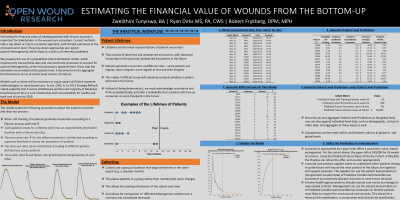Health Economics
(HE-007) Estimating the Financial Value of Wounds from the Bottom-up

Research on the financial value of chronic wounds has been retrospective, at an aggregated level (or top-down), and generally with financial value cast as cost. This research, however, has not been particularly useful to the supply-side stakeholders in wound care; namely, provider organizations and wound-care suppliers. These stakeholders must navigate the economic challenges of the developing gestalt of value-based care. Under this regime, the development of bottom-up prospective models of the financial value of wounds is essential. Hereby, we introduce a novel application of probabilistic latent attribution models to the estimation of the financial value of chronic wound treatment.
Methods:
We obtained transactional data from a large, multi-state, wound care provider organization. The data was split into cohorts based on patient start month. We then randomly selected a cohort, compressed the longitudinal data into three features for parsimony, then split the data into a training and holdout period. We then fit a probabilistic latent attribution model on the training dataset to estimate the parameters of the model. We then used the learned parameters and features of each patient to estimate patient-level transactional and financial metrics longitudinally. We then aggregated data across patient-level data to arrive at cohort metrics.
Results:
The model estimated the individual and cohort-level metrics with high accuracy compared to the holdout data. Moreover, the model generated reasonable estimates of marginal and non-marginal financial value.
Discussion:
Probabilistic latent attribution models allow providers and suppliers to understand the nature of their individual patients and patient cohorts. Because of the range of parameters of interest that are returned at the individual level, they allow for unparalleled flexibility in application. Possible applications include but are not limited to, negotiating value-based reimbursement arrangements, financial risk stratification, pricing the cost of the recidivism of wounds at an individual and cohort level, and revenue estimation. These models should be in the financial toolkit of every healthcare system and wound care stakeholder.
Trademarked Items:
References:

.png)